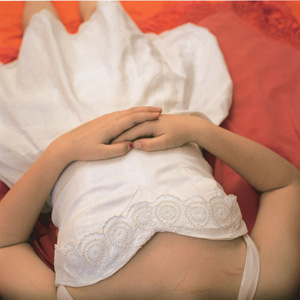
White Dress
Sugar Nights
Deborah Paauwe's images are enigmatic, sensual, erotic, and very loaded. Every frame is composed and constructed in tight asymmetrical close-up. The framing itself is controlled, directed and precisely articulate in application. In this shoot the feminine character(s) are carefully presented, almost symbolically, in a matter that's stylistically confronting as partial bodies. Seductive, self consciously aware, and still, very still, posed, these characters assert a distinctive presence, a performative presence, a fiction. Here the production values are high, psychologically calculated and intelligent. Nothing seems to be left to chance. Every figurative gesture appears restrained, ambiguous, yet is revealed as suggestively explicit, privileged and magnified, allowing a study that explores their underside, their desire. Nothing here is innocent. Everything is more than its appearance - yet there are no establishing shots to meaningfully understand how this scene moves and what is happening or has happened to this character to this subject. They are cool and choreographed with a quality of film noir about them. Her images present scenes of idealised beauty with a hint of the romantic, like you expect in film, conflating the conventions of advertising, fashion, cinema, and personal or fetishized photographs discretely removed from family albums. But the difference here is that Paauwe's powerful and compelling photographs do not act as still photographs but unnerving appeal to our desire to get closer and closer to the subject. Distracted by a sense of abstract violence her work seems to want to induce the viewer to complete the work, to construct the narrative as the photographs intrinsically lend themselves to her (or maybe our) fantasy, and as such operate like a metaphor for the ways in which we relate to or desire the visible. With a resonance of Hitchcock her photographs seem to imply, to invite the consideration of a montage that exceeds the frame, of a space before and/or after action whilst simultaneously excluding their very existence. In her narrative we are deprived of sufficient knowledge to make causal links between the actions of represented events - we are somehow only left with a single fragment a single frame a single detail - a voyeuristic glimpse of hedonism that is inadequate, yet is a strangely complete composition that exists only between the terms of the fictional action(s) itself. To some extent the paradox of each and every image in Deborah Paauwe's project is that they seem somehow to sit outside that continuous movement of time, somehow a frozen composite moment that suggests each image is a filmic detail, that results from a past and a present or perhaps even a space that implies the coexistence of a past and a present rather than a succession of time. In this context her photographs perform like a temporal crisis, a rupture, which enables a conception of time as duration or perhaps a time image, a transformation or metamorphosis which exists in a spatial dimension. In this sense we are forced back to rethink these near perfect yet troubled photographs, these sensual objects of scrutiny, to examine the image itself, to focus on the delicate and tenuous emotions represented, the aesthetic manoeuvres of the partial body that bisects the plane in the attractive psychological moment of performance that is played out in these extraordinary frames. Paauwe's photographs are concerned with, and remind us, of photography's powerful capacity to communicate as photography.
© Nicholas Tsoutas 2000